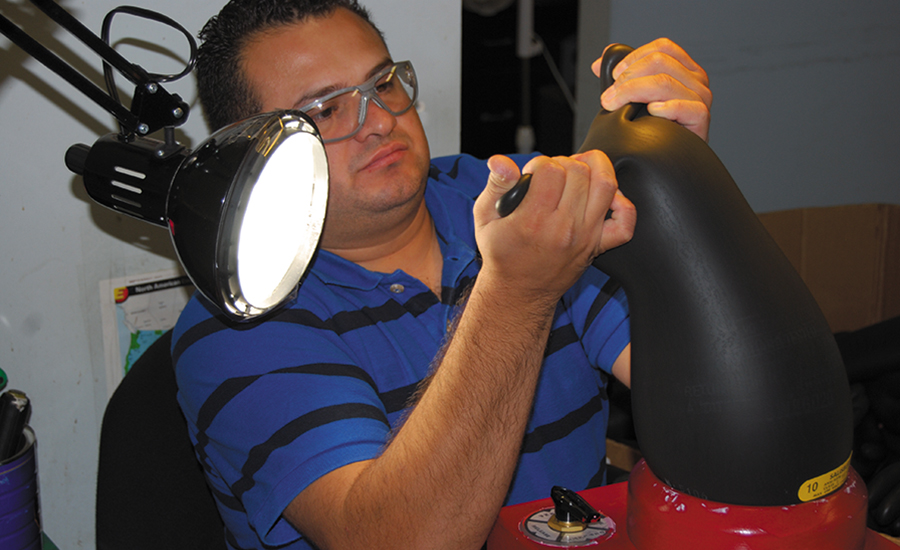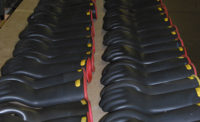Choose the right rubber insulating glove for the task at hand

Arc flash is one of the most dangerous and costly hazards in the workplace today. Most often, when there is an arc flash hazard there is also a shock hazard, so dielectric protection when working on or near energized lines and equipment must be an integral component of the required personal protective equipment. The following procedures can help protect workers against arc flash and shock when used and followed correctly.
Step #1: Dress for safety
Rubber insulating products such as gloves, blankets, sleeves, line hoses and hoods used by electrical workers today are manufactured in accordance with industry consensus specifications under the auspices of the ASTM, the American Society for Testing and Materials. These ASTM standard specifications are referenced in the OSHA regulations dealing with electrical safety, specifically 29CFR1910.137 covering Electrical Protective Devices, and 29CFR1910.269 covering Electric Power Generation, Transmission and Distribution.
Bear in mind that rubber gloves are the only protective gear designed for constant contact with, and protection from, energized conductors and equipment. All other items are designed for protection from accidental, incidental or brush contact.
Take care to choose the correct rubber insulating glove for the task at hand and level of electrical exposure. Rubber insulating gloves are available in six specific voltage classes (Class 00 – Class 4), and other rubber insulating products are available in different voltage classes as well.
- Class 00 low voltage gloves are proof-tested at 2,500 volts for a maximum use 500 volts
- Class 0 low voltage gloves are proof-tested at 5,000 volts for a maximum use 1,000 volts
- Class 1 high voltage gloves are proof-tested at 10,000 volts for a maximum use 7,500 volts
- Class 2 high voltage gloves are proof-tested at 20,000 volts for a maximum use 17,000 volts
- Class 3 high voltage gloves are proof-tested at 30,000 volts for a maximum use 26,500 volts
- Class 4 high voltage gloves are proof-tested at 40,000 volts for a maximum use 36,000 volts
These are all AC voltages. The ASTM standards also include DC test and maximum use voltages.
There is a significant margin of safety between the proof-test voltages and the maximum working voltage. Gloves and other rubber insulating products must be permanently marked to indicate the voltage class, and the gloves and sleeves must also have a color-coded label identifying the voltage class.
Equal care and consideration should also be given when selecting the appropriate leather protector gloves. Leather protector gloves are worn over rubber insulating gloves to extend their life and provide protection to the gloves from cuts, abrasions and punctures. Use the ASTM F696 standard specifying the types of materials, construction and other details as a guide in the selection process.
Step #2: Use the ASTM standard specifications
Various ASTM Manufacturing and Acceptance standards mandate the testing of the rubber insulating products by the manufacturer or supplier prior to the first delivery to the end user. Users also have the option of performing or requiring an acceptance test upon receipt of the goods and prior to placing rubber insulating products into service. Once placed in service, there are periodic re-test intervals specified in the following ASTM standards:
- ASTM F496-08 Rubber Insulating Gloves – 6 months (under certain conditions this can increase to 9 months)
- ASTM F496-08 Rubber Insulating Sleeves – 12 months
- ASTM F479-06 Rubber Insulating Blankets – 12 months
- ASTM F478-09 Line Hose & Covers – when field inspection or company policy warrant
These in-service re-test intervals are the maximum permitted and in addition to the daily field care and inspection. It is quite common for users, including power utilities and contractors, to specify shorter intervals.
Step #3: Always inspect before use
All of the ASTM F496 In-Service standards contain provisions for Field Care, Inspection, and Storage.
Puncture detection may be enhanced by listening for escaping air. While examining the gloves for punctures and other defects, be sure to hold the gloves against the worker’s cheek to feel for escaping air which would indicate a hole in the glove. Next, reverse the glove to check the inside, and repeat the process.
A portable, mechanical inflator may also be used in the field to enhance the inspection of the glove and identification of any damage. Simply affix the glove to the inflator and pump it up to view any damage to the glove that is not otherwise visible unless viewed after inflating. The use of 2-color rubber insulating gloves can also aid in the identification of problems in that any damage to the outer layer enables the inner, contrasting color to be seen.
Finally, do not forget to check your leather protectors every day as well, as dirt and grime can hide damage. Furthermore, be sure to inspect for embedded wires or metal shavings that could puncture or damage your rubber gloves.
Step #4: Utilize proper storage
When not in use, store rubber insulating products in a suitable container such as a canvas bag designed specifically for that purpose. It is permissible, according to ASTM F496, to store rubber gloves inside of their leather protectors, but exercise good judgment. If the leather gloves are wet or damp from working in inclement weather, then remove them from the rubber gloves to allow them to dry. Also remove the leather protectors so that the rubber gloves and leather protectors can both be inspected before the start of the next work day.
There are several field storage options available for rubber insulating sleeves including sleeve roll-ups, canvas sleeve bags and combination bags for storing gloves and sleeves together.
Step #5: Periodically re-test
A qualified electrical testing laboratory helps ensure that rubber insulating products are safe and effective for their intended use. The National Association of Independent Laboratories for Protective Equipment Testing, more commonly known as NAIL or NAILforPET, incorporates the only laboratory accreditation for electrical equipment test labs in the United States and Canada that meets ASTM criteria.
The retest process includes thoroughly cleaning the products, visually inspecting them for physical damage, performing dielectric testing at the rated test voltage and marking and packing the accepted products for return shipment.
Rubber insulating products that have passed the inspection and testing process are marked to identify the test voltage. An effective way to manage the in-service time period is for the electrical testing facility to mark the next RETURN FOR TEST date according to company policy and within the OSHA-mandated ASTM In-Service time frame.
Looking for a reprint of this article?
From high-res PDFs to custom plaques, order your copy today!




